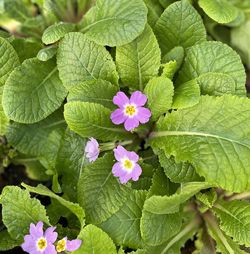Phlox
Chock-full of oomph and charisma, Phlox are enduring warm weather beacons, appreciating moist well-drained soil, frequent deadheading and deep basal waterings. Periodic thinning to just four or six stalks ensures healthier paniculata cultivars.
Phlox amplifolia ‘Winnetou’ (P-2293)
Each $11.50
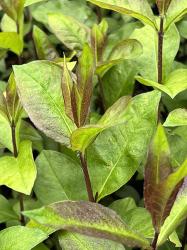
Packing a powerful prismatic punch, the good-sized close-set panicles are composed of dark mahogany flower stems and perfumed bright pink blossoms with bodacious violet-red centers. Apart from its cut-flower perfect posies, ′Winnetou′s mighty guise launches steadfast upright stalks clad in handsome, uniquely large, tapered green leaves enriched by maroon-infused undersides. This hard-to-find German cultivar lends a lush aspect plus untold charisma to well-drained borders or cottage gardens, where it braves most soil types and mesmerizes pollinators.
Blooms July–September
Size: 3' 0" high x 20" wide.
Hardy to zone 4.
Well-endowed with sassy cherry-red flowers clustered in large, perfumed conical trusses, ‘Miss Mary’ is a floral bombshell. Attractive lance-shaped green leaves that tout good mildew resistance plus durable, not-so-tall stems compose her robust, yet compact stance. Awarded a 4-star rating in the Chicago Botanical Garden trials, this must-have pollinator temptress is tailor-made for a midborder position, flaunting reliable, long-lasting brilliant color upon bedfellows such as Sanguisorba ‘Cangshan Cranberry’ or Sedum ‘Neon’.
Blooms July–September
Size: 2' 0" – 3' 0" high x 18" – 2' 0" wide.
Hardy to zone 3.
Phlox divaricata ssp. laphamii ‘Chattahoochee’ (P-1998)
OUT OF PRODUCTION AT THIS TIME
Email me when this plant is available
Consistently receiving the highest ratings in the Chicago Botanical Garden’s Phlox trials and on many a top-10 perennial list, this cherished early-blooming perennial hails from the Chattahoochee River Valley. A probable hybrid between P. divaricata var. laphamii and P. pilosa, the low growing colonizing habit yields glossy lance-shaped foliage topped by airy slightly fragrant clusters of tubular pastel lavender-blue flowers with maroon throats. Its dainty floriferous charm belies an all-around plucky mettle that tackles deer, drought, clay soil and deep shade, while entertaining butterflies, hummingbirds and all who usher it into their gardens.
Blooms April–early June
Size: 9" – 12" high x 16" – 2' 0" wide.
Hardy to zone 3.
Phlox divaricata ‘London Grove Blue’ (P-1946)
OUT OF PRODUCTION AT THIS TIME
Email me when this plant is available
Discovered by the astute folks from North Creek Nursery at a plant sale in London Grove, PA, this handsome shade-happy ground cover is a light blue flowering form of the eastern North American woodland Phlox. The sweetly fragrant 5-petaled blooms are held in loose clusters that lure the butterflies and hummingbirds, while widely spaced lance-shaped green foliage forms an attractive spreading compact clump, coloring fall days with burgundy shades. Appreciative of fertile, adequately moist, free draining abodes, ‘London Grove Blue’ mingles well with Aquilegia ‘Kristall’, Tiarella ‘Dark Star’ and Geranium phaeum ‘Album’.
Blooms April–May
Size: 12" – 15" high x 10" – 18" wide.
Hardy to zone 4.
A vigorous endearing selection of our native woodland Phlox developed by esteemed plant designer Piet Oudolf, ‘May Breeze’ delivers bright sweetly scented accents to shady settings. Quantities of starry, narrow-petaled open blooms gather like pale blue to pure white clouds, floating above oblong deep green foliage. Perfect for weaving amid spring bulbs, Columbines and Beesia deltophylla, this attractive deer-tolerant Phlox slowly spreads to form a small, easily grown, disease-proof semievergreen patch that charms hummingbirds and butterflies plus handles hot humid summers.
Blooms April–May
Size: 12" – 15" high x 10" – 18" wide.
Hardy to zone 4.
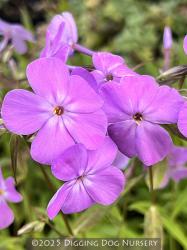
A top-performer at Mt. Cuba’s Phlox trials for its sturdy, disease-resistant habit plus redolent flower-power, ‘Forever Pink’ is the brainchild of Dr. Jim Ault, the Chicago Botanical Garden’s talented plant breeder. Fancied by butterflies and hummingbirds, vivacious 1 in. wide, saturated pink blooms are thankfully sterile, unfurling prior to the paniculatas in early summer, then again in autumn. This Phlox glaberrima ssp. triflora and Phlox ‘Bill Baker’ descendant hosts mildew-free light green leaves and strong upright stems, which form a uniform, mostly evergreen, close-knit basal clump.
Blooms June & September–October
Size: 16" high x 18" wide.
Hardy to zone 4.
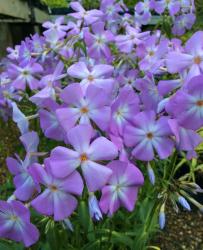
Maximum flower-power and a robust disease-resistant temperament earned ‘Morris Berd’ 4 stars in the Phlox evaluations held at the Chicago Botanical Garden. Oodles of sweet smelling, clear rose-pink flowers populate lovely large panicles, while slim, bluntly pointed leaves with smooth edges define the compact, shiny dark green foundation. A somewhat taller, spring-blooming cultivar, this first-class Phlox detests drought, and flourishes in hot humid weather as well as moist rich niches.
Blooms May–June
Size: 15" – 2' 0" high x 18" – 2' 0" wide.
Hardy to zone 3.
Each $11.50
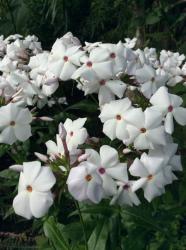
A natural occurring hybrid between Phlox maculata and possibly Phlox glaberrima, this fabulous mildew-resistant Phlox is the happy outcome of a chance roadside sighting in Kemper, Mississippi by plantswoman Karen Partlow. Remaining unblemished all season, the long, slender glossy fresh green leaves clothe firm compact stems, bolstering droves of large rounded clusters with sweetly perfumed, crisp white flowers. Excellent for the front lines or where space is scarce, ‘Minnie Pearl’s virtues are plentiful: lengthy bloom time, short upright stance, slow spreading, pest-free habit and fantastic flowers that beguile the butterflies and hummingbirds and look fetching in a bouquet.
Blooms mid-April–June
Size: 12" – 18" high x 2' 0" wide.
Hardy to zone 5.
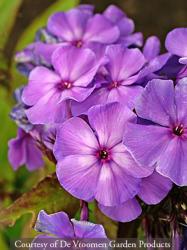
This reliable hard working beauty parades massive ambrosial trusses hoisted by a compact bushy pedestal of well-branched sturdy stems and tailored green leaves that look lush all the way to the ground. The stylish, broad nearly 1 ft. tall blooms unfurl in light blue hues, mature with dazzling deep blue-violet shades and develop reddish purple margins as they age, while their stunning colors appear either more blue or more purple depending upon the light.
Blooms July–September
Size: 2' 0" – 3' 0" high x 18" – 2' 0" wide.
Hardy to zone 5.
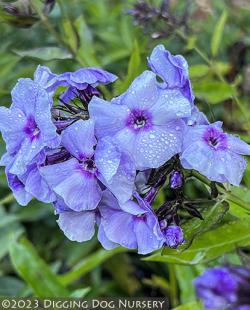
Selected by German plant enthusiast M. Buchner and named for the castle gardens where it was found growing, this early 1900s cultivar is a well-loved enduring heirloom steeped in old-fashioned panache. Substantial fast-developing stems plus handsome green leaves give way to pointed lilac-colored buds and good-sized light violet-blue flowers that showcase prismatic carmine eyes as well as lavender-tinted flip sides. Wafting a heady fragrance laced with jasmine, honeycomb and cinnamon notes, ‘Countess of Schwerin’s posh nearly iridescent panicles can be sprinkled amongst Veronicastrum ‘Cupid’ and Molinia ‘Purple Infusion’, where they nourish butterflies and appear more blue at dusk or upon maturity.
Blooms July–September
Size: 2-1/2' – 3' 0" high x 18" – 2' 0" wide.
Hardy to zone 4.
Phlox paniculata ‘David’ (P-1344)
Each $11.50
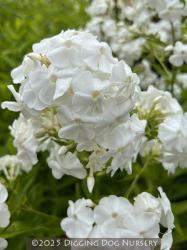
Back in 1987, F. M. Mooberry of The Brandywine Conservancy spotted this outstanding, chance seedling and named it after her husband. A quintessential summertime border plant, ‘David’ is highly prized for his lustrous mildew-resistant greenery and huge, long-blooming fragrant flowers. Shapely triangular panicles illuminated in classic white stand some 6 to 9 in. tall, and nearly as wide, on erect stems with narrow, bristle-edged dark green leaves that are arranged in pairs.
Blooms July–September
Size: 3-1/2' – 4' 0" high x 3' 0" wide.
Hardy to zone 4.
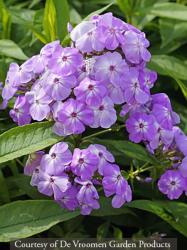
Originating as a chance sport of the esteemed variety, ‘David’, this cultivar flaunts broad, 8 to 10 in. tall, tightly packed flower heads with enchanting lilac hues. ‘David’s Lavender’ is a sophisticated summer mainstay for the garden that lures both gardeners and butterflies alike, especially when accompanied by Persicaria ‘Summer Dance’ and Centranthus ‘Pretty Betsy’. This floriferous Phlox possesses excellent mildew resistance. (PPAF)
Blooms July–September
Size: 3-1/2' – 4' 0" high x 3' 0" wide.
Hardy to zone 4.
Phlox paniculata ‘Gzhel’ (P-2292)
Each $11.50
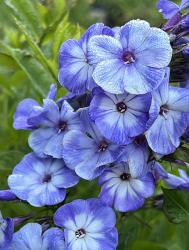
Named for the high-quality folkloric ceramics that originated in Gzhel, a Russian village near Moscow, the large, long-blooming rounded flower heads showcase similar colors above strong lanky stalks and dark green leaves. Vibrant blue-violet, lilac and porcelain-streaked petals swirl around a bright purple eye, their dreamy hues changing with the day’s weather. This coveted seldom-offered Phlox adds grace to cut creations, wafts a sweet scent plus musters a carefree cold-hardy temperament.
Blooms July–September
Size: 3' 0" – 3-1/2' high x 2' 0" wide.
Hardy to zone 4.
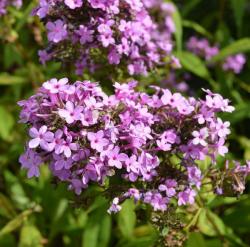
Delighting both gardeners and butterflies, ‘Jeana’s magnificent tiered lavender-pink terminal clusters unfurl in a tightly packed fashion atop brawny, upright branching stems. Discovered by Jeana Prewitt on the banks of Tennessee’s Harpeth River, this delectable Phlox has a lot to toot its horn about: topnotch mildew resistance, perky slender green leaves throughout the season and large sweetly aromatic long-blooming flowers that incite a welcome frenzy of pollinator activity.
Blooms July–September
Size: 3' 0" – 4' 0" high x 2' 0" – 3' 0" wide.
Hardy to zone 4.
Phlox paniculata ‘Juliglut’ (P-2054)
Each $11.50
Developed by famed German plant breeder and nurseryman Karl Foerster, this flamboyant Phlox has been gracing gardens since 1934. German for ‘July Glow’, large conical wine-red panicles put on the ritz atop an upright lusty clump, attired in slender, glistening medium green leaves. Seductive to pollinators and all who behold them, the flirty, scented flowers flash a dark eye, promising to create a summer ruckus in borders or more informal venues when associated with Veronicastrum ‘Erica’, Molinia ‘Purple Infusion’ and Eupatorium ‘Glutball’.
Blooms July–September
Size: 2-1/2' – 3' 0" high x 18" – 2' 0" wide.
Hardy to zone 4.
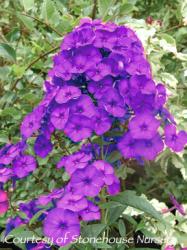
Earning 4 stars at the Chicago Botanic Garden’s Phlox trials, this well-endowed beauty premiers large scented pyramidal trusses poised in glamorous repose atop stiff steadfast stems and slender lance-shaped green leaves. Dark pinkish purple shades, which intensify as the plant matures, saturate the tight set velvet-rich flowers, composed of individual florets, each with a tubular corolla and 5 flat petal-like lobes. A popular attraction for winged visitors and a perfect choice for bouquets, ‘Nicky’ can be planted near Filipendula rubra ‘Venusta’ and Eupatorium ‘Gateway’.
Blooms July–September
Size: 3' 0" – 4' 0" high x 2' 0" – 3' 0" wide.
Hardy to zone 5.
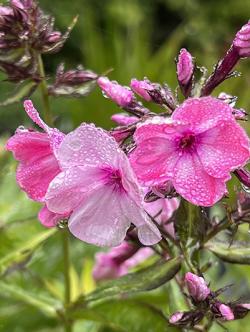
This plucky historic cultivar was introduced in 1938 by acclaimed Russian Phlox breeder Pavel Gaganov. The large close-knit conical heads house marvelous nonfading pale pink flowers, each featuring wavy and somewhat overlapping petals dressed with a luminous white central ring plus a stunning crimson eye. Unparalleled for border plantings, ‘Olenka’s strong, slender, spreading stems and smooth lanceolate green leaves forge a tidy, easy-care mildew-resistant foundation beneath the long-lasting tricolored blooms that tempt pollinators, plant lovers and floral designers.
Blooms July–September
Size: 2' 0" – 3' 0" high x 18" – 2' 0" wide.
Hardy to zone 4.











